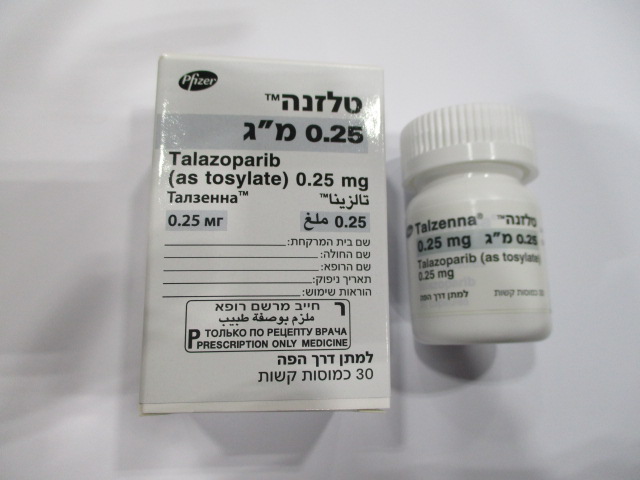Quest for the right Drug

טלזנה 0.25 מ"ג TALZENNA 0.25 MG (TALAZOPARIB AS TOSYLATE)
תרופה במרשם
תרופה בסל
נרקוטיקה
ציטוטוקסיקה
צורת מתן:
פומי : PER OS
צורת מינון:
קפסולה קשיחה : CAPSULE, HARD
עלון לרופא
מינוניםPosology התוויות
Indications תופעות לוואי
Adverse reactions התוויות נגד
Contraindications אינטראקציות
Interactions מינון יתר
Overdose הריון/הנקה
Pregnancy & Lactation אוכלוסיות מיוחדות
Special populations תכונות פרמקולוגיות
Pharmacological properties מידע רוקחי
Pharmaceutical particulars אזהרת שימוש
Special Warning עלון לרופא
Physicians Leaflet
Adverse reactions : תופעות לוואי
6 ADVERSE REACTIONS The following clinically significant adverse reactions are described elsewhere in the labeling: • Myelodysplastic Syndrome/Acute Myeloid Leukemia [see Warnings and Precautions (5.1)] • Myelosuppression [see Warnings and Precautions (5.2)] 6.1 Clinical Trials Experience Because clinical trials are conducted under widely varying conditions, adverse reaction rates observed in the clinical trials of a drug cannot be directly compared to rates in the clinical trials of another drug and may not reflect the rates observed in practice. gBRCAm HER2-negative Locally Advanced or Metastatic Breast Cancer EMBRACA The safety of TALZENNA as a single agent was evaluated in gBRCAm patients with HER2-negative locally advanced or metastatic breast cancer who had previously received no more than 3 lines of chemotherapy for the treatment of locally advanced/metastatic disease [see Clinical Studies (14.1)]. EMBRACA was a randomized, open-label, multi-center study in which 412 patients received either TALZENNA 1 mg once daily (N=286) or a chemotherapy agent (capecitabine, eribulin, gemcitabine, or vinorelbine) of the healthcare provider’s choice (N=126) until disease progression or unacceptable toxicity. The median duration of study treatment was 6.1 months in patients who received TALZENNA and 3.9 months in patients who received chemotherapy. Serious adverse reactions of TALZENNA occurred in 32% of patients. Serious adverse reactions reported in >2% of patients included anemia (6%) and pyrexia (2%). Fatal adverse reactions occurred in 1% of patients, including cerebral hemorrhage, liver disorder, veno-occlusive liver disease, and worsening neurological symptoms (1 patient each). Permanent discontinuation due to adverse reactions occurred in 5% of TALZENNA patients. Dosing interruptions due to an adverse reaction of any grade occurred in 65% of patients receiving TALZENNA; dose reductions due to any cause occurred in 53% of TALZENNA patients. The most common (≥20%) adverse reactions, including laboratory abnormalities, were hemoglobin decreased, neutrophils decreased, lymphocytes decreased, platelets decreased, fatigue, glucose increased, aspartate aminotransferase increased, alkaline phosphatase increased, alanine aminotransferase increased, calcium decreased, nausea, headache, vomiting, alopecia, diarrhea, and decreased appetite. Table 5 and Table 6 summarize the most common adverse reactions and laboratory abnormalities, respectively, in patients treated with TALZENNA or chemotherapy in the EMBRACA study. Table 5. Adverse Reactionsa (>20%) in Patients Receiving TALZENNA in EMBRACA TALZENNA Chemotherapy N=286 (%) N=126 (%) Adverse Reactions Grades 1-4 Grade 3 Grade 4 Grades 1-4 Grade 3 Grade 4 General disorders and administration site conditions Fatigueb 62 3 0 50 5 0 Gastrointestinal disorders Nausea 49 0.3 0 47 2 0 Vomiting 25 2 0 23 2 0 Diarrhea 22 1 0 26 6 0 Nervous system disorders Headache 33 2 0 22 1 0 Skin and subcutaneous tissue disorders Alopecia 25 0 0 28 0 0 Metabolism and nutrition disorders Decreased appetite 21 0.3 0 22 1 0 Abbreviation: N=number of patients. a. Graded according to NCI CTCAE 4.03. b. Includes fatigue and asthenia. Clinically relevant adverse reactions in <20% of patients who received TALZENNA included abdominal pain (19%), dizziness (17%), dysgeusia (10%), dyspepsia (10%), stomatitis (8%), and febrile neutropenia (0.3%). Table 6. Select Laboratory Abnormalities (≥25%) of Patients in EMBRACA TALZENNA Chemotherapy Na=286 (%) Na=126 (%) Parameter Grades 1-4 Grade 3 Grade 4 Grades 1-4 Grade 3 Grade 4 Hemoglobin 90 39 0 77 6 0 decreased Neutrophils 68 17 3 70 21 17 decreased Lymphocytes 76 17 0.7 53 8 0.8 decreased Platelets 55 11 4 29 2 0 decreased Glucose 54 2 0 51 2 0 b increased Aspartate 37 2 0 48 3 0 aminotransferase Increased Alkaline 36 2 0 34 2 0 phosphatase increased Alanine 33 1 0 37 2 0 aminotransferase increased Calcium 28 1 0 16 0 0 decreased Abbreviation: N=number of patients. a. This number represents the safety population. The derived values in the table are based on the total number of evaluable patients for each laboratory parameter. b. This number represents non-fasting glucose. Reporting of suspected adverse reactions Reporting suspected adverse reactions after authorisation of the medicinal product is important. It allows continued monitoring of the benefit/risk balance of the medicinal product. Any suspected adverse events should be reported to the Ministry of Health according to the National Regulation by using an online form https://sideeffects.health.gov.il

פרטי מסגרת הכללה בסל
א. התרופה תינתן לטיפול בסרטן שד גרורתי בחולה עם מוטציה מסוג germline BRCA שלא מבטא HER2, ושטרם קיבל טיפול כימותרפי למחלתו הגרורתית. ב. מתן התרופה ייעשה לפי מרשם של רופא מומחה באונקולוגיה.
מסגרת הכללה בסל
התוויות הכלולות במסגרת הסל
| התוויה | תאריך הכללה | תחום קליני | Class Effect | מצב מחלה |
|---|---|---|---|---|
| טיפול בסרטן שד גרורתי בחולה עם מוטציה מסוג germline BRCA שלא מבטא HER2, ושטרם קיבל טיפול כימותרפי למחלתו הגרורתית. | 30/01/2020 | אונקולוגיה | metastatic breast cancer |
שימוש לפי פנקס קופ''ח כללית 1994
לא צוין
תאריך הכללה מקורי בסל
30/01/2020
הגבלות
תרופה מוגבלת לרישום ע'י רופא מומחה או הגבלה אחרת
מידע נוסף
